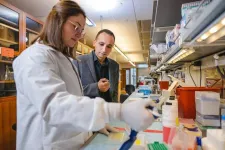(Press-News.org) For the first time researchers have identified patterns of risk for several different types of cancer in men with fertility problems and their families.
The study, which is published today (Thursday) in Human Reproduction [1], one of the world’s leading reproductive medicine journals, found that families of men who have very few or no sperm in their semen have a higher risk of developing cancer, including developing cancer at younger ages, compared to families of fertile men.
The risk and the type of cancer varied greatly depending on whether the men had low numbers of sperm (oligozoospermic) or none (azoospermic), with several cancers identified in distinct clusters of families.
The researchers, led by Dr Joemy Ramsay, assistant professor at the University of Utah, Salt Lake City, USA, hope their findings will improve their understanding of the biological mechanisms involved in both cancer and infertility. This would enable doctors to make more accurate predictions of risk of cancer for men with fertility problems and their families, and to improve the counselling that could be offered to them.
Previous research has shown that male infertility is linked to an increased risk of cancer in the men and their families, but the results have been inconsistent. Increased risks and the types of cancer varied considerably between family groups and depending on whether the men were oligozoospermic or azoospermic.
“In this study, we wanted to describe the extent to which patterns of cancer risk vary between families of subfertile men, and whether this risk is seen in all families or is driven by a small subset of families, akin to the way mutations in the BRCA gene increase the risk of breast cancer in families that carry this mutation,” said Dr Ramsay. “By identifying families with similar patterns of cancer, we may be able to discover factors that are involved in both infertility and cancer.”
Dr Ramsay and colleagues took results from semen analyses carried out between 1996 and 2017 from 786 men attending fertility clinics in Utah, and they matched them with information from 5674 fertile men in the general population who had at least one child to ensure they were fertile. Among the men with fertility problems, 426 were azoospermic and 360 were severely oligozoospermic (with less than 1.5 million sperm per millilitre of semen).
The researchers collected information on first, second and third degree relatives using the Utah Population Database. Cancer diagnoses were identified from the Utah Cancer Registry.
“We simultaneously assessed the risk for multiple types of cancer within each family and then we performed a cluster analysis to find groups of families with similar patterns of risk for multiple cancers,” said Dr Ramsay. “This is the first study to describe these multicancer patterns in families of subfertile men.”
When the researchers looked at all families of azoospermic men, they saw a significantly increased risk of five cancers: bone and joint cancer (156% increased risk), soft tissue cancers such as sarcomas (56% increased risk), cancers of the womb (27% increased risk), Hodgkin Lymphomas (60% increased risk), and thyroid cancers (54% increased risk).
Families of the severely oligozoospermic men had a significantly increased risk of three cancers: colon cancer (16% increased risk), bone and joint (143% increased risk), and testicular cancer (134% increased risk). The researchers also found a 61% decreased risk of oesophageal cancer (cancer of the gullet).
The researchers found the risk of cancer and the types of cancer varied greatly among the families of men with fertility problems, both by type of subfertility and also within subfertility type. This could explain the inconsistent associations between subfertility and cancer in previous studies. For example, the study found an increased risk of testicular cancer in only a third of the clusters of families of oligozoospermic men, but the increased risk ranged from four- to 24-fold depending on family cluster.
Among the families of azoospermic men, the researchers identified 13 clusters of families. One cluster, which included the majority of the families, had a risk of cancer that was similar to that in the general population. However, the remaining 12 clusters all had increased risks of developing at least one type of cancer. Among the families of oligozoospermic men, there were 12 distinct clusters and all of them had an increased risk for at least one type of cancer.
“Our study identified several unique patterns of cancer risk in families of men with poor fertility. When family members share cancer risk patterns, it suggests that they have genetic, environmental, or health behaviours in common. Genetic and environmental exposures can also act together to increase cancer risk. By identifying which groups of families have similar cancer risk patterns we can improve our understanding of the biological mechanisms of both cancer and infertility,” said Dr Ramsay. “It will help us to assess the risk of cancer for families and provide improved patient counselling.”
The researchers have carried out genetic sequencing studies to look for specific genetic mutations that may be driving the associations between subfertility and cancer seen in this study.
Strengths of the study include the use of data from population registries for family structure, cancer diagnosis and subfertility. Limitations include lack of semen measures for the fertile men, lack of information on other health conditions, lifestyle risk factors, such as smoking and body mass index, and exposure to environmental risk factors among the subfertile men; and, finally, that the men with fertility problems in this study were all seen at a fertility clinic and, therefore, represent a subset of the overall population of subfertile men who had the socioeconomic means to be evaluated by a doctor.
(ends)
[1] “Describing patterns of familial cancer risk in subfertile men using population pedigree data”, by Joemy M. Ramsay et al. Human Reproduction journal. doi:10.1093/humrep/dead270
END
Families of men with fertility problems show distinct patterns of increased risk for several types of cancer
2024-02-22
ELSE PRESS RELEASES FROM THIS DATE:
Innovative technology for the comprehensive analysis of membrane protein extracellular interactions.
2024-02-22
1. Background
Many proteins within the body form complexes with other proteins, determining the fate of cells. Therefore, the analysis of protein-protein interactions (PPI) is a crucial process for understanding the biological function of target proteins. Membrane proteins, which account for over 30% of human genes, play a vital role in cell functions. Many membrane proteins are known to form complexes to exert their functions, making the elucidation of membrane protein PPIs essential for understanding protein function. However, the development of technologies to analyze PPIs, especially extracellular protein–protein interactions (exPPIs) of living cells, has ...
Wistar scientists discover link between leaky gut and accelerated biological aging
2024-02-22
PHILADELPHIA—(Feb. 21, 2024)—The Wistar Institute’s associate professor Mohamed Abdel-Mohsen, Ph.D., has demonstrated, with his lab and collaborators, a connection between viral damage to the gut and premature biological aging. The group found that this pro-aging connection can contribute to both gut permeability and premature systemic & intestinal tissue aging in people living with chronic HIV infection, and their discovery is detailed in the newly published paper titled, “Distinct Intestinal Microbial Signatures Linked to Accelerated Systemic and Intestinal Biological Aging,” published in the journal Microbiome.
When people's bodies age faster ...
Chronic exposure to air pollution may increase risk of cardiovascular hospitalization among seniors
2024-02-22
Key points:
Chronic exposure to fine particulate air pollutants (PM2.5) may increase seniors’ risk of cardiovascular hospitalization, with disproportionate impacts on residents of socioeconomically deprived neighborhoods.
The findings suggest that to protect heart health, there is no safe threshold for chronic PM2.5 exposure, and that the EPA’s newly updated standard for the U.S.’s annual average PM2.5 level isn’t low enough to reduce the burden of cardiovascular disease or protect public health overall.
Boston, MA—Chronic exposure to fine particulate air pollutants ...
iTalkBetter app significantly improves speech in stroke patients
2024-02-22
A UCL-developed app that provides speech therapy for people with the language disorder aphasia has been found to significantly improve their ability to talk.
iTalkBetter, developed by the Neurotherapeutics Group at the UCL Queen Square Institute of Neurology, provides users the digital platform to practice over 200 commonly used words, in their own time and without any limits on the amount of therapy they receive.
While employing games to maintain engagement, the app’s integrated speech recogniser analyses speech in real time to give the user feedback on whether they have named the displayed item correctly.
A new study, published in eClinicalMedicine, ...
Intravascular imaging significantly improves survival, safety, and outcomes in cardiovascular stenting procedures over conventional angiography
2024-02-22
Using intravascular imaging to guide stent implantation during percutaneous coronary intervention (PCI) in heart disease patients significantly improves survival and reduces adverse cardiovascular events compared to angiography-guided PCI alone, the most commonly used method.
These are the results from the largest and most comprehensive clinical study of its kind comparing two types of intravascular imaging methods (intravascular ultrasound, or IVUS, and optical coherence tomography, or OCT) with angiography-guided PCI. The study, published Wednesday, February 21, in The Lancet, is the first to show that these two methods of ...
Air pollution linked to increased hospital admission for major heart and lung diseases
2024-02-22
Short and long term exposure to fine particulate matter (PM2.5) air pollution is linked to an increased risk of hospital admission for major heart and lung diseases, find two large US studies, published by The BMJ today.
Together, the results suggest that no safe threshold exists for heart and lung health.
According to the Global Burden of Disease study, exposure to PM2.5 accounts for an estimated 7.6% of total global mortality and 4.2% of global disability adjusted life years (a measure of years lived in good health).
In light of this extensive evidence, the World Health Organization ...
Children born in October least likely to get flu
2024-02-22
Children born in October are both more likely to be vaccinated against influenza and least likely to be diagnosed with influenza compared with children born in other months, finds a US study published by The BMJ today.
The results suggest that birth month is associated with both timing of flu vaccination and the likelihood of a flu diagnosis - and that October is the optimal time for young children to have a flu shot, in line with current recommendations.
Annual influenza vaccination is particularly important for young children, who are at higher risk of flu and severe ...
Uptake of HIV prevention medication doubles with mix of digital health interventions, study finds
2024-02-22
UNDER EMBARGO UNTIL 6:30 PM EST, Feb. 21, 2024
A UCLA Health-led study found a combination of interventions of one-on-one telehealth coaching, peer support forums, and automated text messages more than doubled the use of the HIV prevention strategy, called PrEP, among younger, at-risk Americans, a group that historically has had low use of the medication.
The randomized controlled trial results, published in the journal Lancet Digital Health, tested combinations of interventions to improve HIV prevention behaviors, including pre-exposure prophylaxis, or PrEP, among younger Americans who have historically ...
Seaports are hotspots of contagious cancer in mussels
2024-02-22
Seaports act as hubs for the global spread of MtrBTN2,1 a rare contagious cancer affecting mussels. In this disease, cancer cells can be transmitted, like parasites, from one mussel to another nearby. While, in nature, such contagion mainly occurs between mussels in the same bed, ports and maritime transport facilitate the spread of MtrBTN2 to other locations, through biofouling, whereby diseased mussels attach themselves to ship hulls. This finding, the fruit of research by a team led by scientists from the CNRS and the University of Montpellier,2 will be published in Proceedings of the Royal Society B ...
Cancer leaders pens "letter to the world" calling for urgent investment as global cancer cases predicted to rise
2024-02-22
In their ‘letter to the world’ they say that cancer is a ‘defining health issue of our time’ that requires a united and collective worldwide response on a par with Covid-19. The scientists argue that we’re at a ‘tipping point’ that could transform how we understand and treat cancer – but more support for life-saving research is required to beat the disease.
The letter is published as Cancer Research UK launched its More Research, Less Cancer campaign ...




